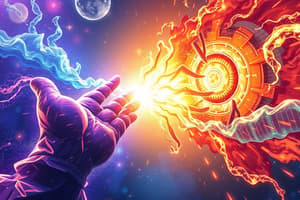Podcast
Questions and Answers
What is the process of converting food into useful forms of energy called?
What is the process of converting food into useful forms of energy called?
Potential energy
Adenosine diphosphate (ADP) provides most of the energy to cells.
Adenosine diphosphate (ADP) provides most of the energy to cells.
False (B)
Carbohydrates can be stored in the body for later use and thus serve as a potential energy source for athletes.
Carbohydrates can be stored in the body for later use and thus serve as a potential energy source for athletes.
True (A)
Energy for skeletal muscles to produce force for exercise comes from adenosine triphosphate (ATP).
Energy for skeletal muscles to produce force for exercise comes from adenosine triphosphate (ATP).
The three systems that replenish adenosine triphosphate (ATP) include creatine phosphate, anaerobic glycolysis, and oxidative phosphorylation.
The three systems that replenish adenosine triphosphate (ATP) include creatine phosphate, anaerobic glycolysis, and oxidative phosphorylation.
The SI unit for energy is joule (J), kilojoule (kJ) is used to express energy in food, and 4.2 kJ is equal to 1 kilocalorie (kcal).
The SI unit for energy is joule (J), kilojoule (kJ) is used to express energy in food, and 4.2 kJ is equal to 1 kilocalorie (kcal).
Both carbohydrates and fats provide 4.2 kcal/g, whereas protein provides 9.4 kcal/g.
Both carbohydrates and fats provide 4.2 kcal/g, whereas protein provides 9.4 kcal/g.
Indirect calorimetry determines energy content of expenditure by measuring changes in oxygen consumption.
Indirect calorimetry determines energy content of expenditure by measuring changes in oxygen consumption.
Resting oxygen consumption is the amount of energy per unit time required by the body to maintain a nonactive but alert state.
Resting oxygen consumption is the amount of energy per unit time required by the body to maintain a nonactive but alert state.
The Doubly Labeled Water technique indirectly measures energy expenditure and allows individuals to participate in their normal, free-living activities.
The Doubly Labeled Water technique indirectly measures energy expenditure and allows individuals to participate in their normal, free-living activities.
The components of Total Energy Expenditure (TEE) include physical activity, Thermic Effect of Food, and resting metabolism.
The components of Total Energy Expenditure (TEE) include physical activity, Thermic Effect of Food, and resting metabolism.
Resting Metabolic Rate can be slightly altered because some components, including exercise, are under voluntary control.
Resting Metabolic Rate can be slightly altered because some components, including exercise, are under voluntary control.
Energy balance refers to the relationship between energy consumed and energy expended in a 24-hour period.
Energy balance refers to the relationship between energy consumed and energy expended in a 24-hour period.
Estimated Energy Requirement (EER) is based on age, gender, weight, height, and physical activity.
Estimated Energy Requirement (EER) is based on age, gender, weight, height, and physical activity.
Prediction equations used to determine Resting Metabolic Rate are precise and accurate without variability.
Prediction equations used to determine Resting Metabolic Rate are precise and accurate without variability.
Flashcards are hidden until you start studying
Study Notes
Energy Conversion and Potential Energy
- Potential energy is erroneously defined as the process of converting food into useful energy.
- Carbohydrates serve as a potential energy source for athletes, highlighting their storage for later use.
Adenosine Triphosphate (ATP) and Energy Sources
- Energy for muscle force during exercise derives from adenosine triphosphate (ATP).
- ATP is replenished through three primary systems: creatine phosphate, anaerobic glycolysis, and oxidative phosphorylation.
- Adenosine diphosphate (ADP) does not primarily provide energy to cells, contrary to a common misconception.
Energy Measurement Units
- The SI unit for energy is the joule (J); energy in food is expressed in kilojoules (kJ), with 4.2 kJ equating to 1 kilocalorie (kcal).
- Carbohydrates and fats provide about 4.2 kcal/g, whereas protein provides 9.4 kcal/g, countering an inaccurate claim.
Calorimetry Techniques
- Indirect calorimetry assesses energy expenditure by oxygen consumption changes, whereas direct calorimetry measures energy through thermal changes.
- The Doubly Labeled Water technique enables the measurement of energy expenditure while individuals engage in normal activities.
Total Energy Expenditure (TEE) and Resting Metabolic Rate (RMR)
- Total Energy Expenditure comprises physical activity, the Thermic Effect of Food, and resting metabolism.
- Resting Metabolic Rate can be influenced by factors such as voluntary exercise.
- Energy balance represents the interplay between energy intake and expenditure over a 24-hour span.
Estimated Energy Requirements (EER)
- Estimated Energy Requirement calculation incorporates age, gender, weight, height, and physical activity levels.
- Prediction equations for determining Resting Metabolic Rate are not entirely precise, as they exhibit variability.
Studying That Suits You
Use AI to generate personalized quizzes and flashcards to suit your learning preferences.




